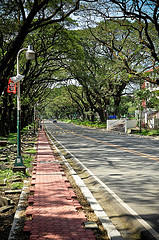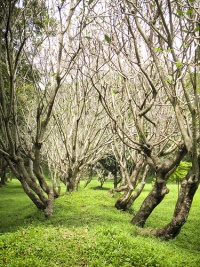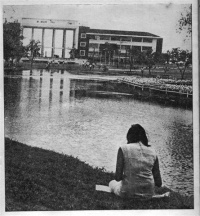UP Lagoon and the Academic Oval
The Academic Oval

The University's academic highway, the Academic Oval covers a distance of 2.2 kilometers. The Oval starts at Quezon Hall, goes full circle towards the different colleges and units, and ends at Plaridel Hall.
The sylvan Academic Oval in the heart of a bustling city is a sight to behold, appreciated most especially by those who frequent the campus.
The Academic Oval, with a perimeter of 2.2 kilometers, is the elliptical campus road maked by the various academic and administrative buildings composed of Quezon Hall, Vargas Museum, Faculty Center, Palma Hall, Gonzales Hall, Benitez Hall, Vinzons Hall, College of Business Administration building, School of Economics building, Malcolm Hall, National Engineering Center building, Melchor Hall, the University Theatre and Abelardo Hall.
The Oval is made legendary by acacia trees, 164 as of the latest count that form a lush canopy around it. The acacia trees are as old as the Diliman campus itself, immediately upon transferring from Pade Faura, President Bienvenido Ma. Sioco Gonzales directed the planting of the acacia trees, to transform the campus from a field of cogon to a forest of trees. The man responsible for this beautification was Professor Jose Vera Santos.
Through the years, the oval has stood as a silent witness to the various marches of students, faculty and staff, in exercise of their cherished freedom of oppression. It is also a convenient route for the Lantern Parade during the Christmas season. Back in the past, the hayride traversed the Oval to cap the Arbor Day celebration.
Another University landmark that can be seen at the Academic Oval are the ikot jeepneys. The ikot, which made its campus appearance in 1955. passes by the oval as if goes around campus to ferry passengers. today, the ikot has its counterpart, the toki, which as the name implies, plies the counter route.
The Oval is the staging place for many art events. In 1998, pedestrians hold the chance to view art installations of the fine arts students making us of 24 of the acacia trees. The site-specific work, aptly titles, Punong-puno ng Sining, dressed up the trees to represent the eight art forms of painting, sculpture, architecture, dance, literature, film, music and theater.

In 1979, trafic lights were installed for a more orderly traffic along the Oval. To keep the campus as a haven for nature lovers, the Oval goes car-less on weekends, from 6 in the morning until 10 in the evening. The scheme enables joggers, bikers and families to enjoy the Oval and its surroundings free from the noise and the smoke pollutants belched out by the motorized vehicles.
Some trivias:
- There is a total of 16 humps along the oval. - The lamp posts around the oval light up at 6 p.m. - The western end of the oval is Kilometer 14 - The eastern end of the oval is Kilometer 15
The Lagoon

More inward from the Queson hall is the UP Lagoon, the only body, no matter how small, of water on campus. The lagoon dissects a vast expanse of land where several glades can be found. The area thus serves as a botanical reserve planted to narra, banaba, kapok, mahogany, royal, rubber, acacia and mango trees, and bamboo, among others. Time was when flocks of sheep and other wild life would graze the area lending it a most pastoral scene on a lazy afternoon on campus.
The lagoon itself is more than a meter deep. It is home to mudfish, catfish, tilapia, and a number of ducks that keeps on dwindling through the years.
The UP Lagoon looked differently decades ago. In the early 1950's, it was just a canal surrounded by tall grasses. Students never dared to go there for fear of snake bites. In the early 1970's the administration started to design plans to develop the lagoon. Concrete steps toward the beautification of the UP Lagoon, however, were not taken until the early 1990's.
Aside from the forest glades that adorn the area, the UP Lagoon is now landscaped with decorative plants complete with benches, tables, wooden bridges, and paved pathways with street lamps. The presence of the Beta Theatrum (courtesy of the Beta Epsilon fraternity) in the area makes it an ideal activity center for cultural endeavors such as concerts and variety shows throughout the year.

Connecting the Amphitheater and the UP Lagoon is the Charter Donor's Garden with a sculpture perched atop a high pedestal at the center. Entitled Three Women Sewing the First Philippine Flag, the polychrome work is by Napoleon Veloso Abueva. With out propensity to call people or places alternative names, the garden has acquired a nickname on account of the sculptural work: Tres Marias Plaza.
The open area, picturesque landscape and airy atmosphere of the Amphitheater and the UP Lagoon combined make them a perfect place for picnics, dates, parties and even aerobics especially during the weekends. For nature lovers, however, the place is simply an oasis essential to contemplation and daydreaming.
source:
Sites and Symbols, UP Diliman Library.
UP Calendar 1996
by: JM Ang Francis Bautista Nikee Estrella


